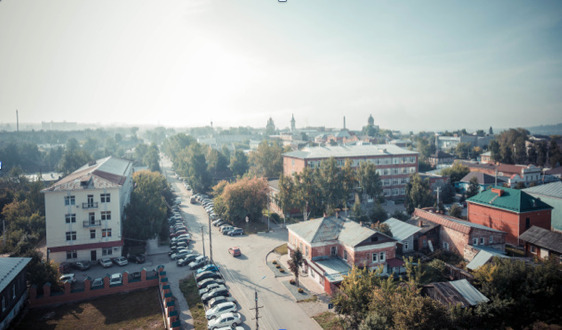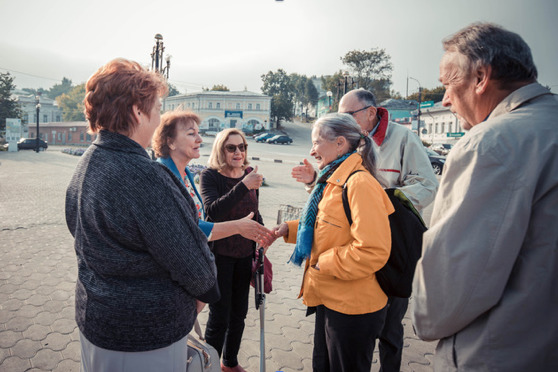Dear Friends,
You may be asking, “How does CCI find all of these Russian people to host Americans in cities and regions across Russia?” It’s very simple. Between 1988 and 2008, we brought more than 8,000 Russians to American cities. They came on various CCI trips: from simple citizen diplomacy to more sophisticated programs such as learning business and non-profit management. They still have a great fondness and gratitude to CCI for their exposure to the outside world and, in many cases, the life-changing business education they received in the U.S. Many still keep in touch with us on occasion. The next paragraph is about one of these Russians whom we hadn’t heard from since 1989.
On June 12th of this year, I received a message from an unknown man in Kungur, a small town in the Perm Mountains region, where the East meets the West in Russia. The email said, “Dear friends, I am one of 400 lucky people who visited the USA in 1989 according to your program, Soviets Meet Middle America. This trip greatly changed my life and since that time I have become the leader of the region-wide Association of Teachers of Foreign Languages. One of our goals is to present the American way of life to Russian students. We would be grateful if we could have a link with a similar organization in the USA and organize an exchange program among our students. We do believe and hope that citizens’ diplomacy is still as workable nowadays as it was in 1989. Sincerely yours, Victor Alexeev, PhD.”
At that very time, I was getting in touch with various Russian cities inviting them to host our September 2018 delegation of American travelers so I answered this email immediately. Victor Alexeev was delighted to get a response and learn that he could host three first-time American travelers to Russia in his small town of Kungur. This town is near Perm, a large industrial city, which had also contacted us in 2017 to inquire if they could in some way participate in CCI’s activities. It was a delight to correspond with this former CCI program participant. Please meet Victor Alexeev!

Victor has a PhD in Education. He teaches English in both higher secondary school classes (high school level) and also at Perm University. “Eleven years ago I founded the Foreign Language Teachers’ Association of Perm Region which is now highly respected in Russia. We have about 300 teachers of English from 90 schools and universities, and every year we organize about 15 differently structured joint projects. All of this is devoted to one goal, which is to develop civic competence in students based on the great example of American democracy. You are absolutely right when you say that now is again the time for citizens’ diplomacy as it was in 1989. I will be happy to work with you on this field.” Victor started organizing his small city to receive three Americans on September 5, 2018! So, here follows the story of Americans from California who visited the Ural Mountain region of Russia.

Sharon Tennison
Center for Citizen Initiatives
Kungur, Russia

Our group was on one side of the river looking down on Kungur. It’s a very, very green, sophisticated small town of about 60,000 well educated inhabitants! As with most Russian cities, Kungur and Perm sprung up around large rivers, their trade routes and tributaries. Early on, Kungur was larger than Perm, but due to a number of circumstances, the situation changed in the late 1800s.


Galina owns a travel agency and her husband is a retired construction company owner. The Americans began getting acquainted with Kungur. On their first full day, they had a tour around the city, visited a public school where they answered well-informed questions from Russian youths, ages 15 to 17 years. A full press conference was scheduled, both television and the local newspaper were present. The event made Kungur’s evening news. According to the Reiners, they as average Americans, were treated like celebrities.




Galina brought cold weather clothing for Frank, Yvette and Ginny so they could descend into Kungur’s famous Ice Caves.

Our U.S. trio soon found themselves in one of the classrooms where Victor teaches English. They took serious questions from the students as the latter passed around a microphone. Wherever our September travelers went, they found Russian students to be well informed and concerned about the relationship between our two countries. Kungur was no exception. “They asked how long it took for us to get visas to Russia, which usually takes a couple of weeks. They were concerned that they cannot get visas at all to travel to our country.”

Russian students appear to be a little more formal than Americans of their age groups. Young women have long tresses like their peers across the world.

After the meeting with students and teachers, the entire group gathered for a photo. Victor must have been proud of his students and fellow teachers. The looks on their faces above tell it all. Unsurprisingly, whenever Americans and Russians meet for even an hour, they spontaneously find common ground. This was the case during the darkest days of Cold War I and has been so each decade since. Our 2018 experience is a continuing validation of this fact. The interest and openness by Russians provides a bizarre contrast to what we read in our mainstream media. Perhaps we should create a CCI trip for our Congress members to go to Russia to meet their congressional counterparts (Duma members), Rotarians, business people and students. Wouldn’t this be good insurance for our common futures?

After the day of meetings with students and teachers, our Americans were invited to stop by Galina’s business. She created her own successful travel agency in central Kungur which employs a staff of 15. Frank (above) enjoyed talking with one of her staff. In another room (below) he collected information from yet another staff member. Frank admits that he is an incorrigible information gatherer!



Our travelers found numerous sophisticated shops of different types, even in smaller cities. Such frivolities in Russia were totally unknown 25 years ago, even in Moscow or other major cities. The massive amount of change that has occurred across Russia over two decades is almost impossible to grasp, given it’s happened in such a brief period of time. Tea shops are minor compared to the huge airports in many large cities, major bridges in numerous regions, renovations of downtown sectors in hundreds of cities small and large, restoration of churches across the countryside, new well-marked and paved highways across the country, huge green houses for non-GMO vegetables in the warmer regions, and attractive new residential high-rises that can be found across the country. For one who traveled across the USSR over the past 35 years, what has happened since 2000 has been a modern-day miracle.

By the way, the first day in Kungur, our Americans were interviewed by the city newspaper, Iskra. Apparently, the article was so well received by Kungur readership, the reporters decided to ask additional questions of their guests. More interviews have been printed about cultural events, such as our national holidays, Thanksgiving and Christmas. Now the Kungur newspaper is communicating with Ginny Aycock via email! Could this be starting another type of citizen diplomacy exchange we hadn’t expected? We hope so!
~~~~~~~~~~~~~~
PERM, Russia
Perm, a city of nearly one million residents, is about an hour’s drive from Kungur. Originally, Kungur was the larger of the two towns. Due in part to its position on large waterways and its subsoil ores for large metal products, Perm zoomed ahead of Kungur in population. It was reported that about half of Kungur’s work force takes the train to Perm to get to their places of employment. It sounds ideal to work in the bustle of a metropolitan area, then catch a train and go home to a small, wooded, quiet community for evenings and weekends.
An array of VIP political and cultural figures have come from the Perm region over the past centuries. For instance, the richest family in Russia during the Tsarist period were the Stroganoffs from Perm (yes, aka beef stroganoff). At one time it was said that the Stroganoff family owned ALL of Siberia, plus holdings in Western Russia. After St. Petersburg and Moscow, Perm is Russia’s third most important cultural city with many art museums and performing halls for classical music and ballet. During WWII, much of the Hermitage art was moved by rail to Perm. At the war’s end, a significant portion was left in the city permanently.
Our travelers arrived in Perm on September 8th. They were met by Perm’s CCI Coordinator, Irina Belouseva. Irina is the current president of the well-known Perm Rotary Club. The Rotarians had created a packed program for their visitors. The first stop was Irina’s home where she invited them to stay rather than at a hotel. As for Irina, the secret is out: she serves fresh caviar with blinis for breakfast! Early on, Irina spent time in the United States. She speaks English fluently with minimal accent. She clearly is a creative entrepreneur who, among other accomplishments, built a private English Language Immersion Camp for Perm’s youth where they only speak English during two-week, live-in sessions. Irina also owns and operates an English Language Academy for adults. Our travelers were told she is also running for the Perm Duma.
The threesome visited The Perm Rotary club, which is known for its long years of Rotary service, the number of Paul Harris Rotary pins on their lapels and the frequency of annual Rotary International Conventions they attend. Each year, quite a few of them travel together to be with other Rotarians in far-away capital cities of the world.
Unfortunately, we have very few photographs from Perm, but we do have this one below!

The Americans’ schedule was so tight and the photos from Kungur so numerous, they may have collectively forgotten to take photos in Perm! Perhaps CCI might ask if another group of Americans might come to Perm in 2019!?
